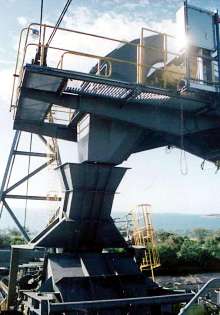Material Transfer System controls material flow.
Share:
Press Release Summary:

Controlled Flow Material Transfer System is comprised of two major components: hood and spoon. In hood section, material from discharge belt is collected and concentrated. Material moving through chute is directed onto spoon, where it is softly and uniformly positioned on receiving belt. Regardless of existing belt configurations, material volume, velocity, and direction are fully controlled. Offerings include uniform, centered loading and elimination of spillage.
Original Press Release:
Parramatta Group's Controlled Flow Material Transfer System
Parramatta Group's introduction of the Controlled Flow Material Transfer System brings a new, yet tested, and proven approach to material handling challenges - one offering the potential for substantial productivity gains and cost reductions.
The innovative system has been designed to alleviate common, costly problems and operational deficiencies associated with material transfers from one belt to another for both simple and complex systems.
Features
The system is marketed with an unconditional performance warranty. The design is comprised of two major components - the hood and spoon. In the hood section, material from the discharge belt is collected and concentrated. As the material moves through the chute, it is directed onto the spoon where it is softly and uniformly positioned on the receiving belt. Regardless of the existing belt configurations, the material volume, velocity and direction are fully controlled.
Advantages
The design offers numerous advantages over conventional transfers, explained Mark Walde, Parramatta Group's general manager. These include:
o The belt is shielded from the direct impact of foreign objects, reducing the potential for belt puncturing and ripping.
o Uniform, centered loading prevents belt-tracking problems and eliminates associated costs.
o Uniform discharge of material onto the receiving belt conveyor.
o Higher production throughput stemming from a chute design with low angles of impact.
o Elimination of the need for a skirt rubber, impact beds, impact troughing sets.
o Reduced space requirements, along with reduced prospects for a transition curve.
o Reduce or eliminate requirements for dust suppression and containment systems.
Benefits
Production capabilities or feed demands can be significantly increased at significantly lower costs. Potential savings can be realized from reduced dust generation and material degradation, as well as from the elimination of costly maintenance associated with impact beds. And because spillage is eliminated, waste is reduced and productivity increases.
Walde explained that the potential exists for substantial savings. While cost reductions will vary for different applications, they can reach levels of tens of thousands of dollars.
He added that Parramatta's application engineers will perform a cost saving analysis for prospective customers. The analysis will pinpoint and quantify savings in key operational areas and compute total annual savings for a Controlled Flow Material Handling System.
Parramatta Group, L.L.C. provides product solutions to vulcanized belt and mechanical belt fastener users on fossil fuel generation, underground coal mining and other large bulk material handling industries. The company's conveyor belt product solutions involve belt cleaners, belt trainers, and skirting systems, belt plows, pulley lagging including ceramic designs and load impact beds.
The company's headquarters are at 12151 Rhea Drive, Plainfield, IL. Its phone number is 815-609-7025; fax is 815-609-0566.




